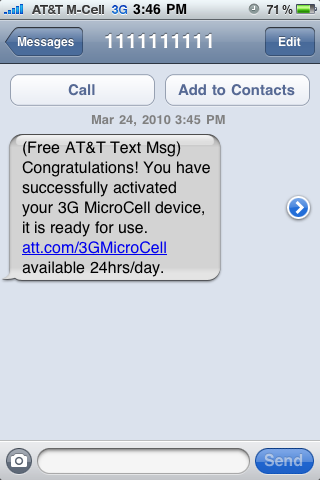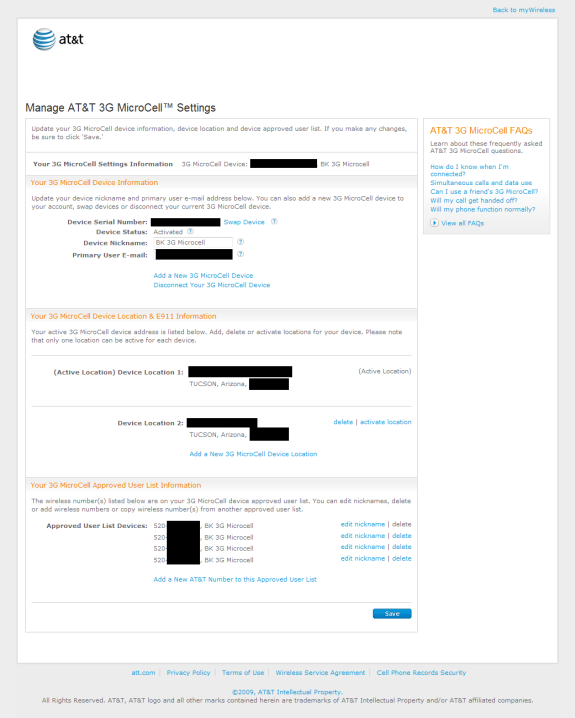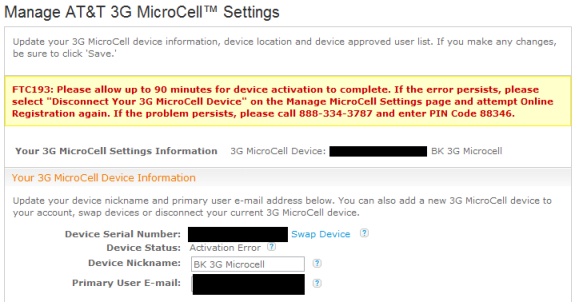AT&T 3G MicroCell: A Comprehensive Exploration
by Brian Klug on April 1, 2010 1:55 AM EST- Posted in
- Smartphones
- AT&T
- Microcell Review
- Mobile
Activating your own personal cell tower
As I mentioned earlier, there's a lot that takes place during device provisioning. Before anything is plugged in, the MicroCell has to be registered online with AT&T for both E911 and spectrum regulatory reasons. As I mentioned earlier, AT&T doesn't want to try and run the femtocell on spectrum they aren't licensed for, and there isn't uniform UMTS 850/1900 MHz licensing across the US. In my market, for example, AT&T is only licensed for the 1900 MHz spectrum.
MicroCell management - Can you micromanage a microcell?
The registration begins by prompting you to enter the device's serial number. Easy enough. Next, it asks for the physical address where the device is going to be used. I was asked for that information while I was at the store, but had to enter it again during registration. This is important because it's used for E911 as well as for verification against the GPS fix the hardware gets. Finally, you enter the approved device phone numbers that will be allowed to use the microcell. At last, you're told it's ok to plug everything in, and it's time to wait - and believe me, wait you will. This is a process that can take up to an hour, though in practice at the two locations I tested, I saw times of between 20 minutes and a 45 minutes.
There's a lot going on behind the scenes during this process, which explains why it can take some time. I noticed on my hardware during the first activation process that the device restarted cold at least once - it's highly likely there's a firmware update with security fixes and updated software that happens. It's also listening for and building a list of macrocells in range for its handoff list, adjusting its own transmission power, and collecting information about what frequencies are active in proximity. All the while trying to get a good GPS fix and provision itself on the network. After the GPS indicator is solid, the 3G indicators will flash either long pulses or very short pulses until the process is complete. Again, there's zero documentation about what long pulses versus short pulses means, but I saw alternating random patterns of both each time. The whole time, aside from the blinkenlights on the hardware, your only status page is the MicroCell management page in the screenshot above. There's very little in the way of communicating what's going on, it'll just let you know that activation is still pending, it's failed, or it's complete.
Oh noes! I didn't take it apart, I swear!
Both times I did this, at the very end of the process the status page briefly communicated that the worst had happened - activation had failed. It's confusing because you'll see the 3G light go solid and your phone join the microcell, but the page will show failed for a minute. Don't panic, look down at your phone. If everything went fine, you should now see "AT&T M-Cell" if you have an iPhone or "AT&T MicroCell" on other hardware as the carrier string:

Yes, they also send you an SMS and email with the news
It took some of my phones just a few seconds to join the microcell and show the carrier string, it took others a minute or two. I found that restarting the hardware unsurprisingly sped the process and assuaged my impatience. Now that it's working, how well does it work?












63 Comments
View All Comments
atiller - Thursday, April 1, 2010 - link
Thanks for the excellent and detailed report. One comment - your view of picocells is rather out of date. Just like femtocells, today's picocells use IP backhaul and can be installed without any specialist skills. Some people call them 'enterprise femtocells', but they have a larger capacity and range than a femto.Brian Klug - Thursday, April 1, 2010 - link
Awesome tip, thanks, I definitely didn't know about these. Do you know what kind of carrier interaction is required for installing one of those? I mean, are they carrier agnostic, some common brand, and can anyone just buy them?I think there's definitely a market for malls and large shopping centers that want to improve coverage indoors - it seems to be a systemic problems for large buildings with high population density inside.
-Brian Klug
Paulman - Thursday, April 1, 2010 - link
Except that I was reading an 4/1/2010 post on a friend's blog which made me wonder when the tech sites would start posting their crazy stories, and then I realized... wait a second...Before realizing this, I had read up to page 4 (Inside the Networking), at which point I was like, "I'm done with this article - I was just really curious to see if this was a 3G signal repeater, or if it got the data through a broadband connection and then just broadcast it locally over 3G". Lol.
TGressus - Thursday, April 1, 2010 - link
...by failed handovers on AT&T.In southern California we as a community drive a lot (serious understatement), and many careers involve driving throughout the work day. Certain devices and occupations have moved my colleagues and family to AT&T at times, including the present. Everyone I know is regularly affected by the worst case handover scenarios you were surprised about in your article.
It so predominant that I estimate 1/4 of my calls with AT&T I answer, "sorry, dropped call" rather than, "hello". It is the consensus of the mobile professionals with whom I interact through AT&T that one can not afford to make important phone calls on the road. I know that must seem like the most obvious statement ever, but try and empathize here; the nature of many businesses in massive urban sprawl lends itself to perpetual mobile telephony.
People regularly attribute these issues to the coverage maps and, more recently, smart-phone burden. I'm no cellular techncian, but I suspect it's something more fundamental with GSM and/or AT&T technology. I'm not surprised you noticed this issue. In fact, I'm surprised you are surprised.
Brian Klug - Thursday, April 1, 2010 - link
I can't speak for the load in that area, but migrating calls and handing them over if the adjacent cell sites are overloaded is generally what causes soft handovers to fail. So imagine that you're on a node, being serviced perfectly fine, but migrate (while driving, say) into an adjacent cell that's completely overtaxed. The phone will try to migrate its session, but if it's so overloaded that it can't, the call will fail.It's a sad state of things, but that's probably what's going on if you see that you have good signal but still encounter problems. In fact, I'd say if you don't hear distortion or blocking, but rather just have the call fail (and you're moving) this is probably the case. Of course, that market is one that AT&T is particularly stressed about and focusing on now, hopefully it improves.
Both CDMA2000, GSM, and UMTS are equally robust in the soft handover arena, and it *usually* works flawlessly - this is a technology that's rolled out pretty much everywhere. The technology is robust, but it's entirely carriers prerogative to install it properly and watch out for these load issues. Nothing is going to overcome the laws of physics. ;)
Cheers,
Brian Klug
slyck - Thursday, April 1, 2010 - link
Comments so far are right on. This should be a choice of last resort only for those who are connected to their cell number. If you need internet to make your call there is always VOIP which costs far, far less.sxr7171 - Thursday, April 1, 2010 - link
Firstly pardon my language here. But this is bullshit.These stupid wireless carriers have a lot of nerve trying to extend their wireless coverage off of the customer's dime. On top of the ridiculous prices they charge for voice and data and most importantly: SMS. They have a lot of nerve asking customers to pay for the device and to pay for calls on it.
The only advantage this has over a VOIP solution is basically seamless hand-offs - WHICH THIS CRAP PRODUCT DOES NOT DO.
For GSM users this functionality was built into the standard and has been around for years and was mentioned in the article: SIP. T-mobile uses it but they restrict the devices.
SIP is a feature built into many open unlocked phones like Symbian phones from Nokia and others, but our US carriers don't like such open phones so they would never allow a carrier sponsored phone to have the SIP software intact in the FW/OS. The whole technology was designed around having a choice of cell phone provider and SIP provider - you know choice as in the kind that creates competition. But our carriers will never allow that, and our consumers will always get sucked into carrier contracts and locked phones. This sort of thing is what makes it impossible to launch a phone or technology without the carrier's blessing and it is what makes us indentured to carriers.
That iPhone is not $200 always remember the $1680 of overpriced service that is part of it. An unlocked iPhone costs $999. Think about why that is. It's because with the carriers control the device prices since they control who can buy it and what services must be purchased and how much that service costs. Will wireless ever be a free market in the US?
HotFoot - Thursday, April 1, 2010 - link
Have to agree with you. This is just silly.Where I live, there are two good solutions for the problem this device/service is trying to solve.
1) Rogers has wifi capable cell phones that will switch to using your home 802.11 (or other hotspots) for making calls. When you're on wifi with these phones, you get different rates for calls much more in line with VoIP.
2) Smart phone that will Skype over wifi. I pay $15/mo for my cell phone service plus another $3 to Skype for unlimited calling in North America. That's $18/mo, no contracts. I did pay $600 for my N900, so if that lasts me 3 years add another $18/mo to the total so I pay $36/mo to have basic cell phone service while I'm out and about and unlimited calling while at home, work, or coffee shop/anywhere there's free wifi.
Anyone feeling like this AT&T offer is a load of steaming crap in comparison?
sxr7171 - Thursday, April 1, 2010 - link
But the 2 are open technologies that were supposed to enable seamless hand-offs and choice of service provider.Wayne86 - Thursday, April 1, 2010 - link
I was hoping this article was an April Fools joke. Alas, after Topekaing, it is not. :)